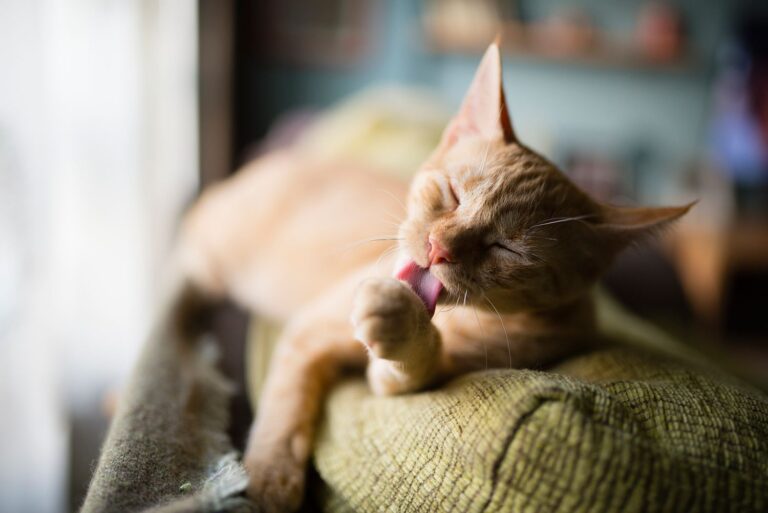Have you ever wondered how your feline friend stays so impeccably clean without ever needing a bath? It turns out that cats are masters of self-grooming, and they have a few tricks up their furry sleeves that make this possible. Their meticulous grooming habits are not just about looking good—they’re a complex biological process that’s essential for their health and wellbeing.
Cats use their barbed tongues to reach and clean their fur. The tiny hooks on their tongues are perfect for removing loose hair and dirt. But it’s not just about the tongue—cats also use their paws and saliva as natural cleaning tools. They’ll often lick their paws and then use them to rub their face and ears, reaching the places their tongue can’t. Did you know that a cat’s grooming routine also helps to regulate their body temperature and improve circulation?
But what about those hard-to-reach spots? Cats are incredibly flexible, able to contort their bodies to clean almost every part of themselves. For instance, they can reach their back by licking their paws and rubbing it over, or by doing a sort of “cat yoga” to lick directly. It’s a combination of agility and acrobatics that keeps them spotless. However, there are times when a cat might need a helping hand—especially if they are older or have long fur that tends to mat. In such cases, a gentle brushing session from their human can be a great aid in their grooming process.
The Science of Cat Grooming

But it’s not all about the tongue. Cats also use their paws as washcloths. Ever noticed a cat wetting its paw and then rubbing its face? That’s a cat giving itself a mini bath! The grooming ritual also stimulates the production of sebum, an oily secretion from their skin that helps keep their coat waterproof and shiny. And let’s not forget about the flexibility factor. Cats have an incredibly flexible spine and shoulder blades that are not attached to the collarbone, allowing them to reach nearly every part of their body. It’s like having built-in yoga skills specifically for grooming purposes!
So, when you see a cat cleaning itself, remember, it’s a complex process backed by biology. It’s their way of staying on top of their game – healthy, happy, and socially accepted among their furry peers. Who knew such a simple act could be so scientifically sophisticated?
Benefits of Self-Grooming in Cats

Firstly, grooming helps cats to regulate their body temperature. Those tiny barbs on their tongues are not just for detangling knots; they also help in spreading their natural oils throughout the coat, which optimizes insulation and cooling. Moreover, grooming is a cat’s way of practicing self-care, as it helps to reduce stress levels and soothe themselves after a potentially stressful encounter.
- Hygiene: Regular grooming keeps the coat free from dirt, parasites, and tangles, promoting overall skin health.
- Stress Relief: Grooming releases endorphins, which help in reducing stress and promoting relaxation.
- Bonding: When cats groom each other, it’s a form of social bonding, which is also extended to humans when they help with grooming.
- Health Monitoring: Through grooming, cats are often the first to detect any abnormalities on their skin or coat, prompting early intervention.
So, the next time you catch your cat in the act of grooming, remember that they’re not just keeping up appearances. They’re engaging in an essential ritual that keeps them happy, healthy, and socially connected. It’s truly one of the many wonders of our enigmatic feline companions!
How Cats Reach Difficult Areas

But how exactly do they manage to keep every inch of their fur pristine? Here’s a quick rundown:
- The Lick and Twist: The most common move in the feline arsenal, where they lick their front paws and use them as a washcloth to clean their face and ears.
- The Back Leg Balancing Act: To reach their lower back and tail, cats often perform an acrobatic act by balancing on their front paws and using their hind legs to clean.
- The Contortionist Stretch: Ever seen a cat cleaning its belly? They can stretch and curl in such a way that they can groom almost every part of their body.
And when all else fails, they’re not above asking for a little help from their feline friends or even their human companions. So, next time you see your cat grooming, take a moment to appreciate the surprising agility and explosive flexibility of our feline friends!
When Cats Need Help with Grooming

Obesity is another factor; chunkier cats might not be able to reach certain areas comfortably. And let’s not forget long-haired breeds; their luscious locks can become tangled and matted without regular brushing. Here’s a quick checklist for when to lend a paw:
- Age-related stiffness or signs of discomfort during grooming
- Any noticeable mats or tangles in their fur
- Excessive licking or grooming that could indicate skin issues
- Post-surgery or when recovering from an illness
- Visible dirt or debris that they can’t seem to clean themselves
If you’re nodding along to any of these, it might be time to give your kitty a gentle brush or seek a professional groomer’s expertise. Remember, grooming isn’t just about looking good; it’s crucial for their health and happiness. So, keep an eye out, and don’t hesitate to help your cat stay on top of their grooming game!
